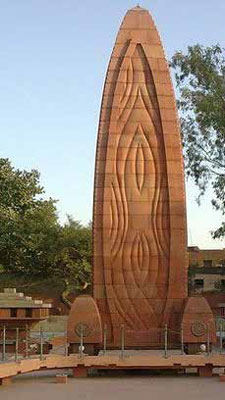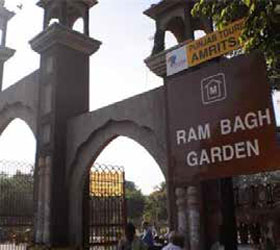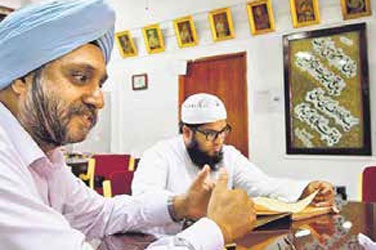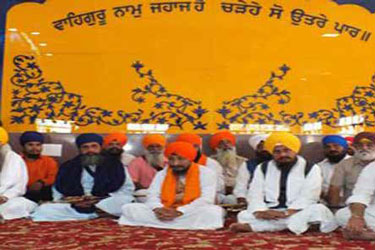helped in its binding and learnt to conserve it with the advice of Salarjung Museum experts. Sajjan Singh takes the help of this museum organising various heritage programme. For example, when 300 Martyrdom Day of Baba Banda Singh Bahadar was celebrated, a special One Day Symposium and Exhibition of Sikh Relics on 29th June, 2016 at Salar Jung Museum Hyderabad was organized by Sikh Heritage Foundation Hyderabad Deccan. The following relics were exhibited – 1. Teer of Sri Guru Hargobind Sahib ji 2. Sfaganj (battle axe) of Sri Guru Har Rai Sahib ji 3. Kada of Sri Guru Tegh Bahadar Sahib ji 4. Hukumnama of Sri Guru Gobind Singh ji 5. Hukumnama of Mata Sunder Kaur ji and 6. Hukumnama of Baba Banda Singh Bahadar. The Symposium was held under the Chairman Ship of S Harpreet Singh IAS Principal Secretary to Governor of Telangana and Andhra Pradesh. The other Scholars were S. Pritam Singh Retd. SP, Dr. Th. Hanuman Chaudhary Director Tata Consultancy Services, Mrs. P. Anuradha Reddy INTACH Convener, Dr Raminder Kaur Medical Superintendent SCR and Mr. Ahmed Ali Curator Manuscript Salar Jung Museum.
The Program concluded with display of Martial Arts (GATKA) by Dashmesh Kalgidhar Jatha. The Deccani Sikhs have their own problems. The persons like Sajjan Singh and others Act as their representatives in putting up their demands before the Sikh authorities as well as the Government authorities. Certain problems have arisen because of the split of the state of Andhra Pradesh in two states. Their status and position are not being recognized and appreciated in the right context which keeps them deprived of certain benefits from the Government.
What Deccani Sikhs now face is a peculiar situation. They are sandwiched between two identities: a) their Deccani culture with historical links to the house of the Nizam, not a popular figure with India’s political elite due to his pro-Pakistan stand at the time of independence and hence under no obligation to honour his last orders; b) and the pressure of being Sikhs outside Punjab. Being a minority among minorities, they are also on no party’s agenda. Muslims constitute 18% of the minority population of Hyderabad, Christians are 7-9% while the Sikhs are just 1%. The dominant Muslim minority gets the cream of reservations. On the other hand, the propagation of the Sikhs’ social culture, leave alone religious culture, find, if at all, intermittent political support.
In 2010, the Sikligar Sikh community (the ironsmiths) was included in the Backward Class (A) category; 285 houses were built for them, but they got no government job or financial assistance. The encroachment by the Wakf Board of the 200-acre Barambala land (gifted by the Nizam, now a busy Hyderabad suburb) has meant the control of the community has dwindled to a mere 65 acres. They further allege that no government has tried reclaiming it on their behalf. Sardar Ravinder Singh, the Karimnagar mayor, a Telangana Rashtra Samithi (TRS) man, is their sole ‘political force’. It’s a political appointment, they wish him well, but Deccani Sikhs expect nothing out of it.
The language and the dress of Deccani Sikhs, being different from main stream Sikhs in Punjab, they also have some grievances against SGPC. It has been their complaint that despite a huge budget, SGPC had not been allocating any funds for their education and raising their social status. They celebrates all Sikh festivals as well as local festivals to have best of the relations with the people living there. For example, There is a tradition in Hyderabad that Sikhs take out a procession on Dassehra day every year. Last year this procession (Nagar Kirtan) started at Central Gurdwara Sahib. Gowliguda and Gurudwara Sahib, Petla Burj simultaneously. They met at Puranapul Darwaza along with Nishans (flags). “The Sikhs worship arms hence they display arms along mock war,” said Sajjan Singh, convener, Sikh Heritage Foundation, Hyderabad. There was display of mock war with Shastr (arms) along with recital of Kirtan. The procession proceeded towards Kishan Bagh. The devout from the three Gurudwaras of Sikh Chawni with Nishan sahib joined the procession. Then they proceeded to Gurudwara Sahib Baram Bala, Sikh Chawni which is the oldest Gurdwara in Deccan region established in 1832. Later, the Nagar Kirtan returns back to their respective Gurdwaras. A langar was organised for the devotees. The president of this organization is S. Harpreet Singh IAS and Secretary are S. Sajjan Singh and S. Surinder Singh architect. Its contact details are email is sikhheritagefoundation@yahoo.co.in and contact number is 9849416143.
S. Sobha Singh’s Gallery
As the Sikh art has a rich historical and heritage value, we have a large number of artists right from the olden times to the present time. The art of Fresco Paintings as reflected on the walls of the Golden Temple is mainly the work of famous Fresco Painter Bhai Gian Singh. Regarding G.S. Sohan Singh, the position has been discussed above. Another famous artist was S. Sobha Singh who made the paintings of Sikh Gurus particularly that of Guru Nanak made on the occasion of the 500th Birth Anniversary of the 1st Guru (1969) and that of Guru Gobind Singh made on the occasion of the 300th Birth Anniversary of the Master (1967). He also made certain portraits of contemporaries. Some of his murals can be seen in the gallery of the Parliament House in New Delhi. S. Sobha Singh was also a prominent sculptor and the busts made by him included that of some eminent Punjabis like M.S. Randhawa and Pritviraj Kapoor. The originals of his work are displayed in his personal art gallery at Andretta (Himachal Pradesh).
Satinder Kaur Kapany Gallery of Sikh Art
Many other artists have their own picture galleries which are a part of our artistic heritage. Whereas we have a gallery of Phoola Rani at Amritsar, we have Arpana Kaur, the Singh twin sisters (Amrit and Ravindra Singh) of U.K., Kulwant Singh of Toronto and Jarnail Singh of Vancouver, who are well known in their field. There are Sikh artists of other kinds also who have perfected in their respective sphere. For example, Gurpreet Singh of Amritsar is a paper artist and Taran Singh from U.K. is a 3D designer and visualizer. S. Vishawjeet Singh of USA is expert in cartooning and S. Harjeet Singh Sandhu living in United States is one of the rare mosaic artists. A unique art gallery has been setup by the Sikh Foundation International (for details of this foundation, refer to Chapter 8). This art gallery is known as Satinder Kaur Kapany Gallery of Sikh Art. In 1999, Dr. Narinder Singh Kapany, Chairman of the Sikh Foundation, made a gift of $500,000 along with 100 Sikh Art objects to the Asian Art Museum in San Francisco. With this generous gift, the Satinder Kaur Kapany Gallery of Sikh Art – named in honour of Dr. Kapany’s wife – was established. This gallery is the first permanent gallery of Sikh Art in North America. Many of the artworks date from the 18th and 19th centuries and are sensitive to light, because of which they can only be displayed for short periods of time. As a result, the content of the Sikh Gallery changes approximately every 6 months. More information about Sikh Art and artists can be obtained from Sanstha’s compilation regarding ‘500 Sikh Role Models’.
Sikh Memorials – Jang-E-Azadi Memorial
We have already mentioned at various places regarding Sikh Memorials erected to commemorate the Sikh historical events and the persons associated with them. When Akali Government was there in Punjab, they got constructed a number of Sikh Memorials to Enliven the Sikh heritage. These monuments include Virasat-e-Khalsa at Anandpur Sahib, Baba Banda Singh Bahadar Memorial at Chapparchiri, and Wadda and Chota Ghalughara Memorials. Another Memorial that came into being recently is the first memorial to commemorate the Sikh contribution for the independence of the country. This is known as Jang-e-Azadi Memorial. Built in Kartarpur town near the city of Jalandhar, it has been built over an area of 25 acres. It’s work started in 2015 under the supervision of a committee of historians, journalists and intellectuals constituted for finalizing the action plan and concept of the memorial. The project has been designed by architect Raj Rewal. This designs includes various galleries which project the different movements of freedom struggle, a tower known as Shaheed-e-Minar, an auditorium, movie hall, open air theatre, Amphitheatre, library and research and seminar halls. Some works are still remaining to be completed. S. Barjinder Singh Hamdard, the Chief Editor of Daily Ajit (a Punjabi newspaper) is the Chairman of the Supervising Committee. Prior to the erection of these Memorials, we had some other memorials also like Anglo-Sikh War Memorial in Gorahoor village near Aahliwal (Ludhiana District) and Firozepur Memorial in the memory of Bhagat Singh, Sukhdev and Rajguru.
Guru Tegh Bahadar Memorial, Delhi
Delhi Government also constructed a memorial named as Guru Tegh Bahadur Memorial at Singhu Border. This memorial has been setup as a tourist attraction with a unique concept and design. Sri Guru Tegh Bahadar Ji has been represented by the central pylon (fabricated in steel), while his three disciples have been represented by the three semi-arches. Also, 10 Sikh Gurus have been represented by the ten monoliths around this memorial. Inscribed with fundamental principles of Sikhism, these monoliths are visible even from a distance of 1-2 kms. Although, these memorials have been made to attract the tourists, the inflow of the tourists is not up to the mark. This memorial has good maintenance and sprawling lawns for organising picnic etc., but the main attraction of the light and sound show seems to have been withdrawn. Further, the symbolic pillars are not clear to many devotees who visit the memorial. If, a museum and a Gurdwara are added, than their will be more visitors. Some people will halt while going from and coming to Delhi for paying their obeisance at Gurdwara, others will like to visit the museum and a good number will come just to have a glimpse of symbolic memorial pillars or for picnics.
When we talk of Sikh Memorials in foreign countries, we have memorials in Holland, Belgium, UK, France and Italy. Most of these memorials are dedicated to the bravery of Sikh soldiers shown by them in various battles fought during the 1st and 2nd World Wars. S. Bhupinder Singh, presently living in Holland has played an important role in setting up various memorials including the famous Ypres Memorial. He had started research work in 1996, whereby he collected precious information and rare photographs of the martyr Sikh soldiers during the world wars. He has written two books, ‘How Europe is indebted to the Sikhs’, two volumes, and the two works on contribution of Sikhs in both world wars, namely ‘Sikhs in World War I’ and ‘Sikhs in World War II’. These two books are a sort of mini archive of the Sikhs. It is because of his efforts that annual celebrations in Holland and Belgium for remembering these brave soldiers are organized. In May 2018 a gathering at Dam Square in Amsterdam paid homage to the Sikh soldiers of the Second World War. This kind of celebration is being organized by the national committee every year since 1999. Again in Nov 2018, 100 years of the end of First World War was celebrated in Eiper Menon Gate (Belgium) where also the soldiers who gave their lives were remembered through a prade led by Five Pyaras followed by Miri Piri Gatka Party of France’s wonderful performance. S. Bhupinder Singh is also a great source of inspiration for the World Sikh Shaheed Military Yaadgari Committee, Italy to which the credit goes for creating maximum number of Sikh memorials.



